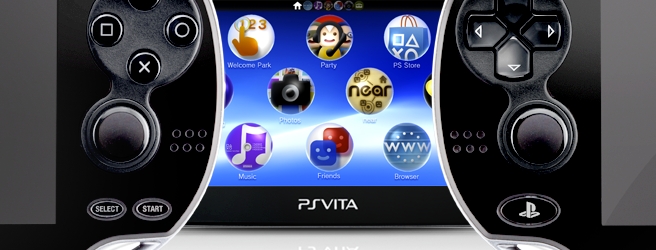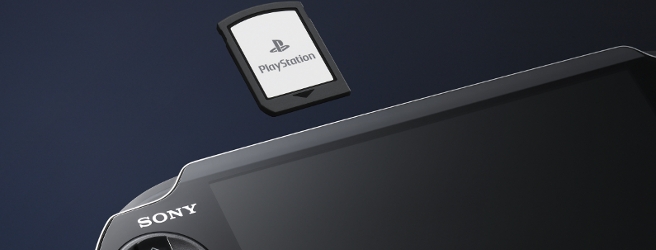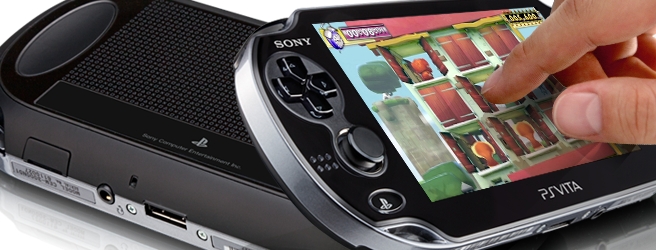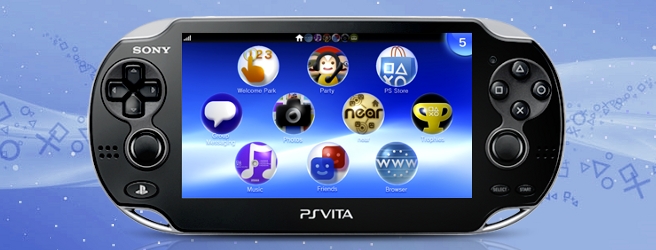The guys at GR love to poke fun at me about being a PlayStation fanboy. But that’s really not true. I’m a hardware fanboy. I love tech. I love gadgets. I love shiny new things with power oozing from it. I’m the type of guy who upgrades his smartphone twice a year and always has to have the next big thing. When you compare the Nintendo Wii to the Xbox 360 and then to the PS3 in terms of power and capabilities, I can’t help but lean towards the PS3. It was the last hardware launch I was genuinely excited for… until the PlayStation Vita. I so wanted the 3DS to be that device, I really did. But Nintendo seems to have again skimped on power under the hood for a gimmick (sorry, but the 3D isn’t good enough).
The Vita has that cutting-edge techy feel to it, and that 5-inch OLED screen seals the deal. It’s simply gorgeous. The capacitive touch panel gives the PlayStation Vita the only rear-end that I find sexier than Kim Kardashian’s. The analog sticks are a god-send. They make me want to track down the dope that created circle pads and give him a good shaking. They’re real analog sticks, working perfectly to replicate the home console experience.
Motion and tilt controls are much more responsive than the SIXAXIS control of PS3 controllers. The D-pad and face buttons are a little smaller than what you’re used to, but it takes only moments to acclimate. The built-in cameras sacrifice resolution for frame-rate, allowing for better functionality for games and augmented reality. AR on the 3DS is instantly impressive, but lacks depth or speed, hampering its effectiveness for gaming. The Vita fixes this. The Vita is seemingly the perfectly built device.

The Vita looks like the PSP, only slightly bigger and more rounded. It’s lighter by far. It feels well-built, but I can’t imagine it surviving a far drop, especially because the OLED screen is so massive. The entire face of the device is this glossy, glassy plastic; there’s no separation from the face and the screen. Screen-protectors will look stupid on it. Then again, you may not even need one; the screen has held up very well thus far.
You will, however, want to carry around a screen wipe or those little wipes for glasses to keep it smudge-free. Even after cleaning, it shows smudges everywhere. The rear touch-panel is the same shiny plastic, but fingerprints don’t show as bad. In the two indents where your fingers rest on the back, there’s this weird porous feeling plastic designed for added grip (I assume). Strangely, it feels like it sucks the moisture from my skin, to the point where I have decided to put hand cream on before I play. But you need those indents; otherwise, your fingers can graze the touch panel. Chances are that if you can't figure out why your taps and swipes aren't registering, it’s because your finger is on the touch panel, if ever so slightly. At first I panicked, thinking this would be a major issue, but keeping your fingers off quickly becomes second nature.
The UI is snappy and more like a smartphone than a game system. I thought I’d be sad to see the XMB go, but now I say good riddance. The Vita’s LiveArea UI makes the PS3 seem archaic. Tapping on a “bubble” on the home screen opens the app’s own LiveArea where you can launch the app, the web-browser, or the PlayStation Store to download DLC. You can have up to six of these applications open at once.
Tapping the PS button brings back up the LiveArea screen, which you can then drag the corner to close or swipe left or right to access another open app. Hitting the PS button again brings up an old Xbox-style blade system, giving you a look at all the apps you currently have open. You don’t have to close any apps to open more, as opening anything over six apps automatically closes the sixth app in line. All of it is fast, intuitive, and snazzy all-around.

As great as everything is, there is one major problem with the PlayStation Vita: the memory cards. You MUST have one, if not several. Some games won’t even start without one. It’s so important to the system that it’s ridiculous Sony isn’t including one bundled with the Vita. They’re also expensive, proprietary, and fill up far too fast because of their size.
You may be thinking, “Wow, the digital releases of Vita games are so much cheaper… I’ll buy all digital to save money!" Those were my thoughts initially, too. But sticking just Ultimate Marvel vs. Capcom 3 and Little Deviants on a 4GB card filled it – that's two games. Simple, rough math says that you can fit 16 games on a 32GB card, the largest card offered for the Vita. And it costs $100 or more. That’s a hefty premium to have digital games.
Worst of all, they’re hard to find. They’re sold out at retailers in Japan, and they won’t even be made available in Europe at launch. Do yourself a favor and pre-order a 32GB card, so you don’t have to hunt one down when you inevitably need more space. I don’t know if they’re hard to manufacture or if Sony is forcing people to buy more than one card, essentially double-dipping.
It’s a shame. The Vita is an amazing device that could have avoided this added mandatory expense. Try to think of it like this: The proprietary flash memory and the Vita’s content management system exists to thwart piracy—something that plagued the PSP and led to its early demise in the States. Developers stopped creating software for it outside of Japan for that very reason. That’s one way to spin it. Unfortunately, they're passing the cost of stopping piracy onto you, particularly with the Vita only being able to accept one PSN account. This added cost, though understandable, is equally detrimental.
The battery life is mediocre as well. It won’t last as long as a smartphone, but it’s not terrible either. About three and a half hours is all you’ll get playing a powerhouse like Uncharted: Golden Abyss. Simpler tasks require less battery, therefore extending battery life, but not considerably so. There’s a lot of processing power in the Vita, and that OLED display is so very bright. The trade-off in battery life is necessary for the Vita to be the device that it is.

The PlayStation Vita also plays nicely with a PS3. Most of this compatibility hasn't yet been realized, but we fully expect it to get better with age, like a fine, vintage Pinot Noir. Remote Play is nearly useless at the moment, something that Sony needs to work on ASAP. Even Killzone 3, the one PS3 game that Sony showed to work with the Vita via Remote Play, doesn't (I went out and bought a copy just to test it for this review). On the upside, games like wipEout 2048 are capable of Cross-Platform play, allowing you to play versus PS3 users online from your Vita. That’s just too cool for school.
Then there’s game-save transferring, or "transfarring" as Hideo Kojima has branded it. This allows you to play a game on your PS3, swap the save file over to the Vita, and pick up where you left off while on the go. The value there is infinite. Now, if only greedy publishers would find a way to package a Vita and PS3 version of a game for a low, affordable price, this feature will be pure gold. For the console version of Ultimate Marvel vs. Capcom 3, the Vita can be used as a controller, taking advantage of the touch-screen to perform moves. It’s not a reason to buy the Vita, but it speaks of the potential of the device as a companion to the PS3. It’s pretty much everything Nintendo should have done over the years with their portables and home consoles, but never truly achieved.
As with any new hardware, it’s the software that’s truly important. This is yet another area where the PlayStation Vita shines. It’s launching in the US on February 22, 2012 with the best launch library I’ve ever seen. Uncharted: Golden Abyss is a home console experience through and through. Even the graphics are near PS3-quality. Both first- and third-party games are plentiful, offering a nice mix of established franchises and fresh experiences. Each Vita game takes advantage of the unique hardware in exciting ways, mashing up traditional console play with just a touch of intuitive smartphone touch-play. But only time will tell if the software releases can remain steady and offer experiences that cannot be found anywhere else. That’s going to be what makes the PlayStation Vita stand-out amongst the 3DS and mobile platforms.
I see things going one of two ways for the PlayStation Vita, with little room in-between. It’s either going to succumb to smartphones as pundits are too quick to predict and never really take off, or it’s going to go for the complete surprise and become the new Game Boy, maybe even the Walkman of the 21st century that Sony hoped the PSP would be. It’s that good, but the competition is also that fierce.
-
OLED screen is stunning
-
Console quality gaming on the go
-
Real analog sticks
-
Well-built device with tons of features
-
Did I mention that the screen is gorgeous?
-
Strong software support out of the gate
-
Rear touch panel adds more input possibilities
-
Remote Play is a disappointment... for now
-
Memory cards and pricing











